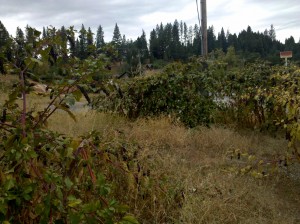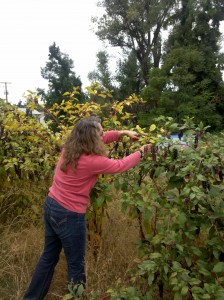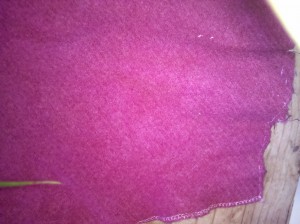Down in the Pokeberry Patch
What are pokeberries? Not a surprising question for a Northern California grrl… this is a native plant in the South and considered mildly invasive here. In fact, when I first read about Rebecca Burgess’ results with pokeberries in Harvesting Color, I was amazed and surprised since I had never seen a pokeweed bush in my life! Then, Dr. Sara Gottfried mentioned dyeing with Rebecca, and some of the medicinal properties of the plant as lymph cleanser, stating we should dye our bras with this beneficial juice! (As a special note at this point, this plant is POISONOUS to EAT!!) So, I looked up Carol Leigh’s information, upon which the recipe in the book is based. She has done lots of work with this plant to come up with a dye method that is colorfast, and one of her secrets is making an acidic dye vat; the other is using LOTS of plant material.
Since I still hadn’t ever seen the plant, except in photographs, I filed the information away and continued my work collecting and drying garden plants and Sierra Nevada natives, that is, until last weekend. My fiber guild works all of the first weekend in October at the annual Celtic Festival, and it is a good time to catch up with my fiber grrls, one of which is Luci, an agricultural biologist for Nevada County. We were spinning away at our spinning wheels when she casually said, “Have you gotten any pokeberries from that patch at Railroad Avenue?” She verified that this was a lot with a for sale sign, no buildings, no people around, etc. Nobody would care if I went to pick the berries, and some would thank me for reducing the possibility of the spread of yet another invasive.
Off I went the next day, accompanied by my able helper, DD Nikki. We found the patch right where Luci said, and Nikki was amazed, saying that less than two years ago there had been a Christmas Tree lot at the spot and NO berry patch!
I was able to harvest about 30 pounds rather quickly, cutting the large clusters and dropping them into the bag while Nikki held it. Kind of reminded us of old times, when my poor children had to help pick all varieties of foodstuffs for the family larder!
Wet weather came our way starting on Tuesday, so I began the process of vinegar mordanting yarn while stripping berries into a pot. Another secret to getting the rich colors promised was not letting my kettles get to the high simmer or boil stages. I ended up watching them constantly, and keeping the lids off so that the temps stayed in the steeping range, and was well-rewarded.
I couldn’t throw the dye bath, still rich in color, out – even though Carol Leigh says that the deepest concentrations are needed to get the most colorfast results. So, the next morning I set about mordanting a chunk of white blanket wool I had found at Humble Fabrics, our local re-store of the craft world. That simple piece of cloth turned out almost as amazing as the yarn.
I wasn’t able to fit all of the berries into the initial batch, so cooked up another (smaller) kettle’s worth last night, added it to the original dye liquid, and then today dyed four ounces of llama/shetland roving. That batch is still soaking in the dye, so no photos yet, but I am looking forward to how it differs and to spinning it up over the winter.
My experiments may or may not prove to be lightfast as Carol’s or Rebecca’s, but they sure are beautiful. I decided that I would make a lace shawlette with the sportweight yarn, so that I wouldn’t need to wash it as frequently as the socks I had originally envisioned. The blanket wool will be turned into applique bits for sewing projects, while the destination of the spinning fiber is uncertain as yet. The fiber would make nice winter hats. Colorfastness will probably last as long as I need or want these projects to last, and I will be interested to follow those experiments that others try with this unusual plant.
I did determine that this is not a viable plant to use for resale. The volume of plant material and the labor involved in processing is much greater than other choices. I will save using it for my own special, and very occasional, projects. If you love this color, keep your eyes out for pokeweed in your area and let me see photos of your results!












Hi,I recently ended a one month test for light fastness on my pokeberry dyed yarn. I used Carol Leigh’s vineger method for mordant and a couple of skeins vere mordanted with alum. I got wonderful results that were colorfast, but the color faded significantly after having the tester yarns exposed to the sun for 4 weeks (September/October) The only one piece that didn’t show any fading was the yarn from Pit River Wool Company that you had mordanted with rhubarb leaves. The color is a warm carmine red, very beautiful. I am going to make a few more tests with overdyeing to see if the result will be lightfast as well.
Anni Redding
will this dyeing process work on buckskin,deer or elk hide if so how would this be done? I would be using this for my Native american Regalia,thanks for any information.
There are dyes that will work for hides, though I do not know much about them… check this link for some possible help: http://www.paleotechnics.com/